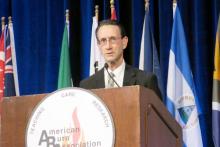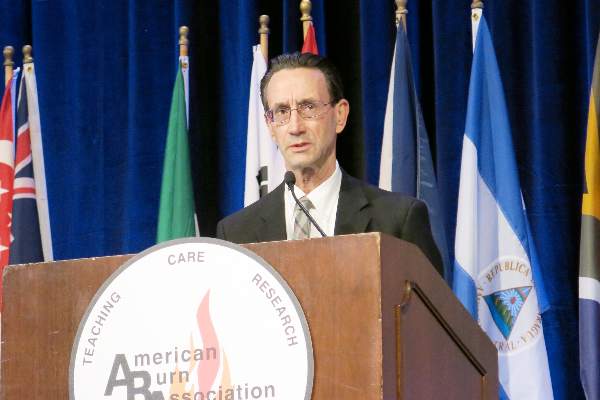User login
CHICAGO – Rehabilitation time is directly associated with a reduced rate of contracture and a better range of motion, irrespective of the extent of burn injury, results from the prospective ACT study showed.
The Acuity, Contractures, Time (ACT) study examined outcomes and rehabilitation time in patients with burns involving 10% or less of their total body surface area (n = 177) and in those with burns involving more than 10% of total body surface area (n = 130). Joint range of motion was recorded based on cutaneous functional units at the time of discharge for all 307 patients enrolled from September 2010 through December 2013 at five verified burn centers across the United States. Most patients were men (71%).
Overall, 79% of the patients had burn scar contracture. Based on range of motion for 8,068 joints analyzed, 66% had burn scar contracture.
For patients with burns affecting 10% or less of their bodies, only rehabilitation time per cutaneous functional unit significantly differed between those with and without burn scar contracture (4.6 minutes vs. 2.4 minutes; P<i/>= .002). The same was true for patients with burns affecting more than 10% of their bodies (3.3 minutes vs. 1.4 minutes; P<i/> < .0001).
“One of the impetuses to do this study in this manner was the realization of what most therapists say all the time: They don’t have enough time to treat their patients in the hospital,” Reg Richard, P.T., said at the annual meeting of the American Burn Association.
During a discussion of the study at the meeting, Mr. Richard said he hoped the results would be used to improve rehabilitation services for burn patients and called on the ABA to lead the charge.
ABA President David Ahrenholz of Regions Hospital Burn Center, St. Paul, Minn., said in an interview that coverage of rehabilitation services varies from insurer to insurer, and physicians can’t point to an absolute number to say this is the minimum number of rehabilitation days needed to obtain a good outcome in a specific patient.
“This is the first pass of an unbelievably large data set,” Dr. Ahrenholz said “I think it will be transformative ... to help the insurers to understand that it isn’t just a number of sessions, but that we’re looking for an outcome and that the therapy should continue until we get the desired outcome.”
In the ACT study, a univariate analysis found patients with no contracture were significantly more likely than those with contracture to have shorter hospital stays (12 days vs. 14 days; P value = .02), burns with a lower percentage of body surface area involvement (5% vs. nearly 10%; P<i/> < .0001), fewer skin grafts (2.3% vs. 4%; P<i/> = .001), more rehabilitation time per total body surface area involvement (6.1 minutes vs. 4.5 minutes; P<i/> = .003 ), and more rehabilitation time per cutaneous functional unit (4.4 minutes vs. 2 minutes; P<i/> < .0001), Mr. Richard from the U.S. Army Institute of Surgical Research, JBSA Fort Sam Houston, Texas, reported.
In multivariate regression analysis, rehabilitation time per cutaneous functional unit was the only significant predictor of preventing burn scar contracture and lost range of motion for patients with small burns (Odds ratio, 1.07; 95% confidence interval, 1.02-1.12) and for those with larger burns (OR, 1.36; 95% CI, 1.18-1.74).
Further analyses are warranted, as the results were based on the variables used and present analysis methods, he said.
On Twitter @pwendl
CHICAGO – Rehabilitation time is directly associated with a reduced rate of contracture and a better range of motion, irrespective of the extent of burn injury, results from the prospective ACT study showed.
The Acuity, Contractures, Time (ACT) study examined outcomes and rehabilitation time in patients with burns involving 10% or less of their total body surface area (n = 177) and in those with burns involving more than 10% of total body surface area (n = 130). Joint range of motion was recorded based on cutaneous functional units at the time of discharge for all 307 patients enrolled from September 2010 through December 2013 at five verified burn centers across the United States. Most patients were men (71%).
Overall, 79% of the patients had burn scar contracture. Based on range of motion for 8,068 joints analyzed, 66% had burn scar contracture.
For patients with burns affecting 10% or less of their bodies, only rehabilitation time per cutaneous functional unit significantly differed between those with and without burn scar contracture (4.6 minutes vs. 2.4 minutes; P<i/>= .002). The same was true for patients with burns affecting more than 10% of their bodies (3.3 minutes vs. 1.4 minutes; P<i/> < .0001).
“One of the impetuses to do this study in this manner was the realization of what most therapists say all the time: They don’t have enough time to treat their patients in the hospital,” Reg Richard, P.T., said at the annual meeting of the American Burn Association.
During a discussion of the study at the meeting, Mr. Richard said he hoped the results would be used to improve rehabilitation services for burn patients and called on the ABA to lead the charge.
ABA President David Ahrenholz of Regions Hospital Burn Center, St. Paul, Minn., said in an interview that coverage of rehabilitation services varies from insurer to insurer, and physicians can’t point to an absolute number to say this is the minimum number of rehabilitation days needed to obtain a good outcome in a specific patient.
“This is the first pass of an unbelievably large data set,” Dr. Ahrenholz said “I think it will be transformative ... to help the insurers to understand that it isn’t just a number of sessions, but that we’re looking for an outcome and that the therapy should continue until we get the desired outcome.”
In the ACT study, a univariate analysis found patients with no contracture were significantly more likely than those with contracture to have shorter hospital stays (12 days vs. 14 days; P value = .02), burns with a lower percentage of body surface area involvement (5% vs. nearly 10%; P<i/> < .0001), fewer skin grafts (2.3% vs. 4%; P<i/> = .001), more rehabilitation time per total body surface area involvement (6.1 minutes vs. 4.5 minutes; P<i/> = .003 ), and more rehabilitation time per cutaneous functional unit (4.4 minutes vs. 2 minutes; P<i/> < .0001), Mr. Richard from the U.S. Army Institute of Surgical Research, JBSA Fort Sam Houston, Texas, reported.
In multivariate regression analysis, rehabilitation time per cutaneous functional unit was the only significant predictor of preventing burn scar contracture and lost range of motion for patients with small burns (Odds ratio, 1.07; 95% confidence interval, 1.02-1.12) and for those with larger burns (OR, 1.36; 95% CI, 1.18-1.74).
Further analyses are warranted, as the results were based on the variables used and present analysis methods, he said.
On Twitter @pwendl
CHICAGO – Rehabilitation time is directly associated with a reduced rate of contracture and a better range of motion, irrespective of the extent of burn injury, results from the prospective ACT study showed.
The Acuity, Contractures, Time (ACT) study examined outcomes and rehabilitation time in patients with burns involving 10% or less of their total body surface area (n = 177) and in those with burns involving more than 10% of total body surface area (n = 130). Joint range of motion was recorded based on cutaneous functional units at the time of discharge for all 307 patients enrolled from September 2010 through December 2013 at five verified burn centers across the United States. Most patients were men (71%).
Overall, 79% of the patients had burn scar contracture. Based on range of motion for 8,068 joints analyzed, 66% had burn scar contracture.
For patients with burns affecting 10% or less of their bodies, only rehabilitation time per cutaneous functional unit significantly differed between those with and without burn scar contracture (4.6 minutes vs. 2.4 minutes; P<i/>= .002). The same was true for patients with burns affecting more than 10% of their bodies (3.3 minutes vs. 1.4 minutes; P<i/> < .0001).
“One of the impetuses to do this study in this manner was the realization of what most therapists say all the time: They don’t have enough time to treat their patients in the hospital,” Reg Richard, P.T., said at the annual meeting of the American Burn Association.
During a discussion of the study at the meeting, Mr. Richard said he hoped the results would be used to improve rehabilitation services for burn patients and called on the ABA to lead the charge.
ABA President David Ahrenholz of Regions Hospital Burn Center, St. Paul, Minn., said in an interview that coverage of rehabilitation services varies from insurer to insurer, and physicians can’t point to an absolute number to say this is the minimum number of rehabilitation days needed to obtain a good outcome in a specific patient.
“This is the first pass of an unbelievably large data set,” Dr. Ahrenholz said “I think it will be transformative ... to help the insurers to understand that it isn’t just a number of sessions, but that we’re looking for an outcome and that the therapy should continue until we get the desired outcome.”
In the ACT study, a univariate analysis found patients with no contracture were significantly more likely than those with contracture to have shorter hospital stays (12 days vs. 14 days; P value = .02), burns with a lower percentage of body surface area involvement (5% vs. nearly 10%; P<i/> < .0001), fewer skin grafts (2.3% vs. 4%; P<i/> = .001), more rehabilitation time per total body surface area involvement (6.1 minutes vs. 4.5 minutes; P<i/> = .003 ), and more rehabilitation time per cutaneous functional unit (4.4 minutes vs. 2 minutes; P<i/> < .0001), Mr. Richard from the U.S. Army Institute of Surgical Research, JBSA Fort Sam Houston, Texas, reported.
In multivariate regression analysis, rehabilitation time per cutaneous functional unit was the only significant predictor of preventing burn scar contracture and lost range of motion for patients with small burns (Odds ratio, 1.07; 95% confidence interval, 1.02-1.12) and for those with larger burns (OR, 1.36; 95% CI, 1.18-1.74).
Further analyses are warranted, as the results were based on the variables used and present analysis methods, he said.
On Twitter @pwendl
AT THE ABA ANNUAL MEETING
Key clinical point: Rehabilitation time was associated with reduced risk of scar contracture and lost range of motion in burn patients.
Major finding: For patients with burns affecting 10% or less of their bodies, only rehabilitation time per cutaneous functional unit significantly differed between those with and without burn scar contracture (4.6 minutes vs. 2.4 minutes; P = .002). The same was true for patients with burns affecting more than 10% of their bodies (3.3 minutes vs. 1.4 minutes; P < .0001).
Data source: Prospective, observational study in 307 burn patients.
Disclosures: The study was funded by a U.S. Department of Defense grant.

